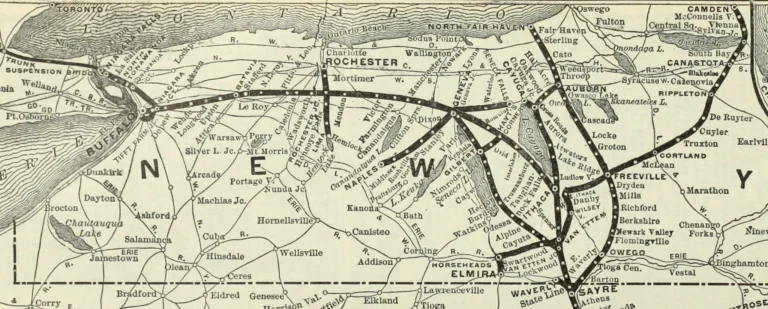
The history of the Lehigh Valley (LV) in New York State began in late 1867 when the railroad extended a line northward from the Pennsylvania anthracite coal fields to a connection with the Erie Railroad at Waverly, NY. The LV was a standard gauge railroad and the Erie operated on a six foot gauge, requiring freight from the LV to be transferred to Erie cars for the journey to Buffalo. The following year the Lehigh Valley paid for the Erie to lay a third rail from Waverly to Buffalo allowing the LV to send its cars directly to Buffalo without any costly and time-consuming transfers.
The third rail on the Erie gave the Lehigh Valley access to Buffalo, but the company wanted to establish its own line to the city. In October 1876 the LV acquired the Geneva, Ithaca and Athens Railroad. This line extended about 75 miles from Sayre, PA to Geneva, NY.
The Lehigh Valley Railway Company was chartered in 1883 to construct a 10 mile line from Buffalo to Lancaster. The LV also expanded its Roselle Branch to gain access to the waterfront in Jersey City across from New York City. The 97 miles between Lancaster and Geneva was the only gap between Jersey City and Buffalo. The Buffalo and Geneva Railroad was completed in 1892 connecting Lancaster to Geneva and completing the Lehigh Valley’s main line between New York and Buffalo.
The Lehigh Valley operated until April 1, 1976 when it was absorbed in the new Conrail system.
For a more detailed information, see the Lehigh Valley Railroad Corporate History page.
Branches
- Auburn Branch – North Fair Haven, NY to Sayre, PA
- Auburn and Ithaca Branch – Auburn to Ithaca
- Elmira and Cortland Branch – Elmira to Camden
- Ithaca Branch – Ithaca to Geneva Junction
- New York Main Line – Buffalo to Sayre, PA
- Naples Branch – Geneva to Naples
- Niagara Falls Branch – Niagara Junction to Niagara Falls
- Rochester Branch – Rochester to Hemlock
- Seneca Falls Branch – Geneva Junction to Cayuga Junction
- Willard Branch – Hayt’s Corner to Willard
Maps
Timetables
Learn More
Coming Soon!



